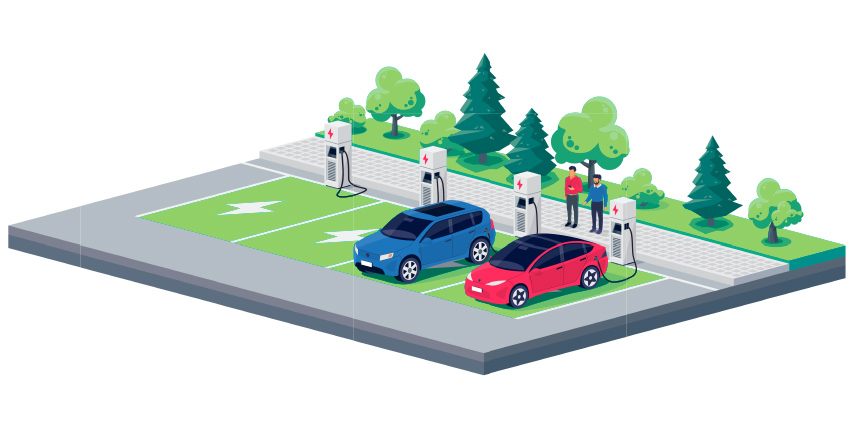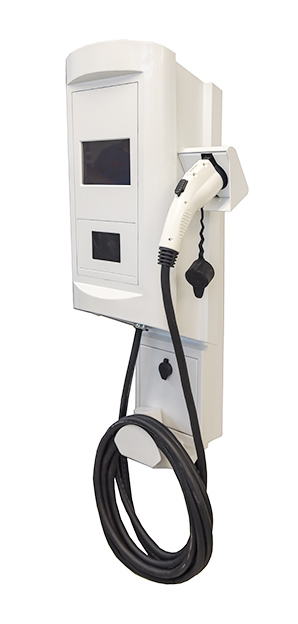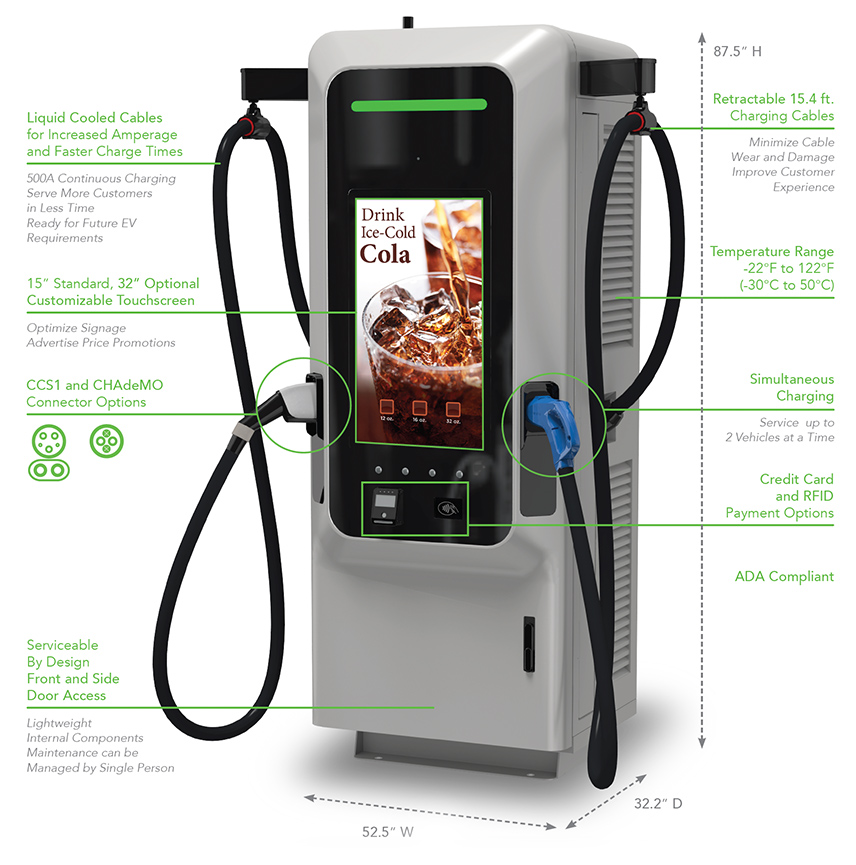
Deciphering the differences, features, and benefits of both
Electric vehicles (EVs) and charging stations are all over the news. With tremendous consumer demand for EVs and new federal subsidies to build a national EV charging infrastructure, retailers and property developers are moving rapidly to install chargers that will make EV Charging stations quick, accessible and convenient. This is a great starting point in your journey of finding the right EV charger manufacturer.
However, not every site is the same, and neither is every charging station. What works for one installation may not be the right choice for another. So how do you decide what’s best? When faced with investing in a charger for your business or location, it pays to examine the distinctive features each technology offers to help make a better choice.
There are two basic power types available for charging an EV: AC (alternating current) or DC (direct current) charging platforms.
Alternating current or AC electricity reverses its direction multiple times every second. Most power grids around the globe are based on AC current. For example, in the United States power grid, every second, the AC power reverses its direction 60 times. Transformers reduce high voltage and control the stream of power that travels from the grid into homes and businesses.
Direct current or DC electricity is a power source that runs in one direction only. Many modern technologies rely on DC power for their batteries. EVs, computers and LEDs rely on DC electricity.
EV batteries can only store power in DC form. EVs come with an AC to DC converter, which allows an EV to charge with an AC power source but has limitations due to spatial and thermal constraints. DC power is not restricted by an EVs onboard converter, allowing for faster charging speeds.

Factors that can impact an EV charging speed
While the type of charger selected has an enormous impact on potential charging time, most of the limiting factors that can impact the charging speed are imposed by the vehicle itself, specifically the vehicle battery. These factors include:
- Capacity – Each EV battery has a different capacity for its current and voltage limits. This capacity is the single biggest determining factor for speed of charge.
- Ambient Temperature – Extreme cold impacts the actual battery chemistry. As part of passenger comfort in winter months, it is more than likely the driver will turn on interior heat. This cabin heat, combined with the freezing weather, can cut the EV’s range by as much as 41 percent. The cold impacts charging speed and directly impacts vehicle performance.Fortunately, most modern EVs are able to “pre-condition” their batteries, which heat the batteries for faster charging speeds in colder weather.
- Degradation – Over its lifetime, an electric vehicle battery will gradually lose its ability to retain a charge and increase the time it takes to complete a charge.Heat is the main contributor to degradation, but is mitigated with an EV’s Battery Management System.
- Battery Management System (BMS) – This system is responsible for the charging and preservation an EV’s battery. A BMS sets charging speeds but can also enable cooling and heating for the battery to optimize battery life and charging speeds.
- Active loads – Any electronic system within the vehicle run off the battery also draws on its power. Therefore, any electricity being consumed for purposes other than propelling the vehicle forward creates a “load” that decreases the charging speed. For example, if a driver is sitting in their EV with the heater on while their EV is charging, their EV will take longer to charge since the heater is using energy.
- State of Charge (SoC) – This indicates how full the battery is and is usually described as a percentage. At a lower SoC, an EV will charge at faster rates but will decrease over time at high SoCs to prevent the battery from overcharging.
Future-proof your charger by looking into DC fast chargers
Note the first limiting factor in that list: capacity. Battery developers are engaged in an ongoing race to continually improve EV battery capacity, help cure “range anxiety,” and decrease charging times.
Currently, it might not make sense to have a 500amp charger for an EV that only accepts 300 amps; however, as vehicle batteries improve, business owners should consider installing a charger capable of handling vehicles coming in the next year or two that will have batteries with higher acceptance rates. Above all, you do not want the charger to be the limiting factor for the charge time. Installing the right charger with adequate capacity can help extend the return on investment. Also, you don’t want to be overshadowed by the business next door with the DC fast charger.
The power rating at the chargers supplied by BTC POWER® is generally much higher than the current capacity for most EVs. However, this charger capacity helps future-proof the charger so business owners that install one today need not worry about obsolescence and the cost to reinstall a new charger once battery technologies improve.
The three levels of speed for EV charging equipment, including AC and DC chargers
That said, there are diverse levels for charging units that each pose advantages and disadvantages, depending on the use case scenario.
Level 1
A Level 1 charger represents the slowest type of charge but perhaps the most convenient for individuals because it can operate using a standard residential outlet of 120 volts. This would be an AC charger. An empty battery can take 50-60 hours to charge using a Level 1 charger.
Level 2
Level 2 chargers also are AC-powered. Assorted styles of level two chargers are designed to handle either residential 240-volt outlets or commercial outlets of 208 volts. A Level 2 charger is smaller than a DC charger and less expensive for the initial capital outlay due to the lack of rectification components. These components significantly increase the complexity and cost of the unit.These are considered “destination” chargers, as it can take hours at a time to fully charge a car.
A Level 2 charger can charge a completely empty EV battery in anywhere from four to ten hours, and a hybrid vehicle battery within one to two hours. These are easy to install in almost any location, from an individual’s garage or home to small businesses.
One BTC POWER model, for example, is L2 Single Port, which is offered in 30 amps, can function as a wall-mounted or pedestal option, and is also available in duel port. It offers quick release from the power connections and is small and lightweight for more economical shipping, storage, and installation.

Level 2 chargers are available as single phase or split phase options. Their benefits include initial cost, size, and ease of installation. However, buyers should be aware that as with any AC charger, the speed is slower than a DC charger.
Possible use case scenarios may be a workplace where staff is on location for several hours. Another use case would include destination locations or anywhere that guests or patrons would stay for several hours or overnight to allow adequate time for charging. These could include hotels, multi-family complexes, resorts or even entertainment facilities.
BTC Power sells wall-mounted or pedestal versions of Level 2 chargers, in 30-, 40-, and 70-amp versions.Pedestal chargers can stand alone near sidewalks or spaced out in a parking lot, if they are connected underground to the power grid. The 70-amp Level 2 charger is designed for fleets and commercial vehicles, such as buses, or delivery vans, parked overnight in a dedicated lot.
DC fast chargers (Level 3)
Level 3 chargers are DC chargers, which output DC to the vehicle. Rapid chargers will have kilowatt (kW) capabilities of 50 kW and up. The higher the kW capability, the faster it will charge. These are much faster than any AC-type charger, as it converts AC to DC within the charger and bypasses an EVs onboard AC to DC converter, charging the battery directly.
A rapid charger can charge a compatible EV from zero or empty to 80% in less than an hour. BTC POWER recently introduced its GEN4 180-kW All-In-One (AiO) DC fast charger, supplying enough power to reach 80% on an EV battery in as little as 12.5 minutes.

Fast chargers such as the 180 kW All-In-One charger with this level of power transfer meets use case scenarios where there are larger vehicles or a quick turnaround benefits the business owner. This could include fleet operators for transit shuttles, school buses and other specialty vehicles, or on the retail side, fueling stations, convenience stores and retail outlets.
The footprint on these fast-charging stations is sized similar to a standard gas pump and are built with sufficient charging capabilities to adapt to increased power capacity of future vehicles.
Why 80% and not 100% EV charging?
Car owners often charge the car battery to 80% for a few reasons. First, as the battery gets close to its 80% charge, the charging slows for the remaining ten or 20 percent charge to reduce the risk of damaging the battery. It can take almost as long to charge the last 10 percent capacity of an EV battery as it takes to charge the first 90 percent.
Secondly, it can help extend the life of the battery to reach 80% and stop the charge.
To recap the difference between AC and DC charging. AC charging is or can be:
- Cost competitive – Individuals can use a dedicated EV AC charging station or a standard household outlet
- Convenient – Can be completed slowly overnight
- Available – Due to the ability to charge using a standard outlet
These same benefits can prove detrimental depending on the circumstances. The convenience and availability also are related to:
- Slow speeds—Commercial outlets cannot serve multiple customers requiring electricity if the time stretches for hours or overnight.
DC charging is:
- Fast—The battery charges directly because it doesn’t need to convert the power. This drastically slashes the charging time from hours to minutes.
- High power—Most DC charging stations can charge a vehicle’s battery up to 80% capacity or more in 30 minutes or less.
- Future-proofed—The higher capacity of a DC fast charger can meet the needs of EVs as manufacturers improve their battery capacity.
- ROI—Businesses that rely on a steady stream of customers to maintain profitability can increase traffic by flipping customers more rapidly due to faster charging times and the ability to power two vehicles at once using a dual charger.
- Possibly funded – Some programs, such as NEVI, can fund 80% of the cost.
BTC POWER offers unique and customizable charging station options for either AC or DC power. Still unsure which power source might best suit your needs? With an installed base of more than 20,000 charging stations worldwide, BTC Power is the ideal partner as an EV charger supplier to help you sort through your technology options. Please visit www.btcpower.com.
